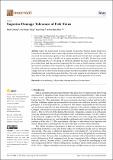| dc.contributor.author | Zhang, Emily | |
| dc.contributor.author | Tung, Chi-Huan | |
| dc.contributor.author | Feng, Luyi | |
| dc.contributor.author | Zhou, Yu Ren | |
| dc.date.accessioned | 2023-01-20T16:18:27Z | |
| dc.date.available | 2023-01-20T16:18:27Z | |
| dc.date.issued | 2023-01-19 | |
| dc.identifier.uri | https://hdl.handle.net/1721.1/147608 | |
| dc.description.abstract | Skin is the largest organ of many animals. Its protective function against hostile environments and predatorial attack makes high mechanical strength a vital characteristic. Here, we measured the mechanical properties of bass fish skins and found that fish skins are highly ductile with a rupture strain of up to 30–40% and a rupture strength of 10–15 MPa. The fish skins exhibit a strain-stiffening behavior. Stretching can effectively eliminate the stress concentrations near the pre-existing holes and edge notches, suggesting that the skins are highly damage tolerant. Our measurement determined a flaw-insensitivity length that exceeds those of most engineering materials. The strain-stiffening and damage tolerance of fish skins are explained by an agent-based model of a collagen network in which the load-bearing collagen microfibers assembled from nanofibrils undergo straightening and reorientation upon stretching. Our study inspires the development of artificial skins that are thin, flexible, but highly fracture-resistant and widely applicable in soft robots. | en_US |
| dc.publisher | Multidisciplinary Digital Publishing Institute | en_US |
| dc.relation.isversionof | http://dx.doi.org/10.3390/ma16030953 | en_US |
| dc.rights | Creative Commons Attribution | en_US |
| dc.rights.uri | https://creativecommons.org/licenses/by/4.0/ | en_US |
| dc.source | Multidisciplinary Digital Publishing Institute | en_US |
| dc.title | Superior Damage Tolerance of Fish Skins | en_US |
| dc.type | Article | en_US |
| dc.identifier.citation | Materials 16 (3): 953 (2023) | en_US |
| dc.contributor.department | Massachusetts Institute of Technology. Department of Materials Science and Engineering | |
| dc.identifier.mitlicense | PUBLISHER_CC | |
| dc.eprint.version | Final published version | en_US |
| dc.type.uri | http://purl.org/eprint/type/JournalArticle | en_US |
| eprint.status | http://purl.org/eprint/status/PeerReviewed | en_US |
| dc.date.updated | 2023-01-20T14:23:16Z | |
| dspace.date.submission | 2023-01-20T14:23:16Z | |
| mit.license | PUBLISHER_CC | |
| mit.metadata.status | Authority Work and Publication Information Needed | en_US |
